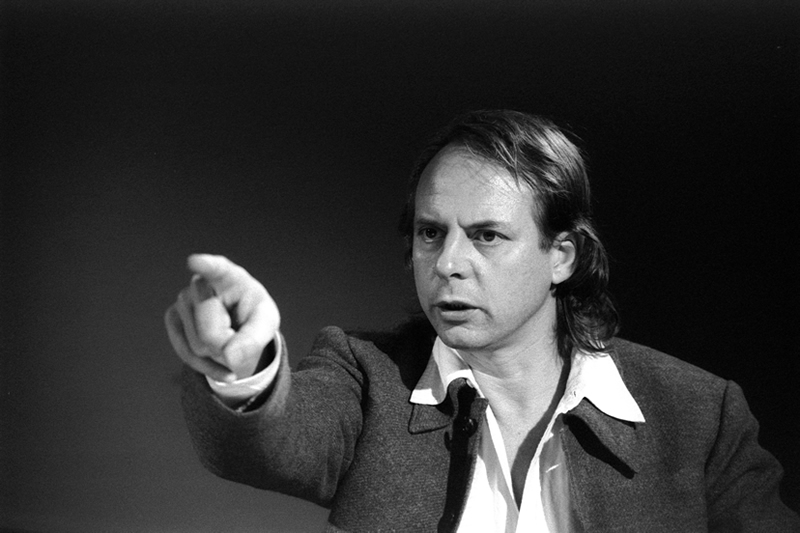
Instrumentation Works for Orchestra
Stockhausen Complete Edition on CD
Since 1991, a complete edition of all recordings in which Karlheinz Stockhausen has personally participated is being released on compact discs. Each CD in this series is identified by Stockhausen's signature followed by an encircled number. The numbers indicate the general historical order of the works.
Stockhausen realised the electronic music and participated in these recordings as conductor, performer, sound projectionist, and musical director. He personally mixed down the recordings, mastered them for CDs, wrote the texts and drew the covers.
- The compact discs may be obtained from the Stockhausen-Verlag: Kettenberg 15, 51515 Kuerten, Germany (www.stockhausenCDs.com).
Karlheinz Stockhausen
Instrumentation Works for Orchestra
CARRÉ
COMPLETE ORCHESTRA
| 2 flutes |
| 1 alto flute |
| 2 oboes |
| 1 english horn |
| 3 clarinets |
| 1 bass clarinet |
| 3 saxophones (alto, tenor, baritone) |
| 3 bassoons |
| 3 trumpets |
| 1 D-trumpet |
| 1 bass trumpet |
| 4 trombones (alto, 2 tenor, bass) |
| 1 bass tuba |
| 6 horns (3 high, 3 low) |
| piano |
| vibraphone |
| cymbalum (with microphone) |
| harp (with microphone) |
| The harp part may be supplemented by an electrically amplified harpsichord. The conductor determines what is played by the harp or by the harpsichord and what is played by both instruments together. |
| 8 percussionists: 8 tomtoms, 4 bongos, 12 cowbells, 4 cymbals, 4 hihats, 4 gangs, 4 tam-tams, 4 bunches of indian bells, 2 bass drums, 4 snare drums with strings (very bright) |
| chorus 8-8-8-8 (or 12-12-12-12) |
| strings (without contrabasses) 8-8-8-8 |
| total number of musicians: 77 instrumentalists 32 (or 48) singers 4 conductors |
| favourable hall: 25 m x 25 m measurements of platforms: 4 platforms 5,25 m x 12 m, 50 cm high seating arrangement: |
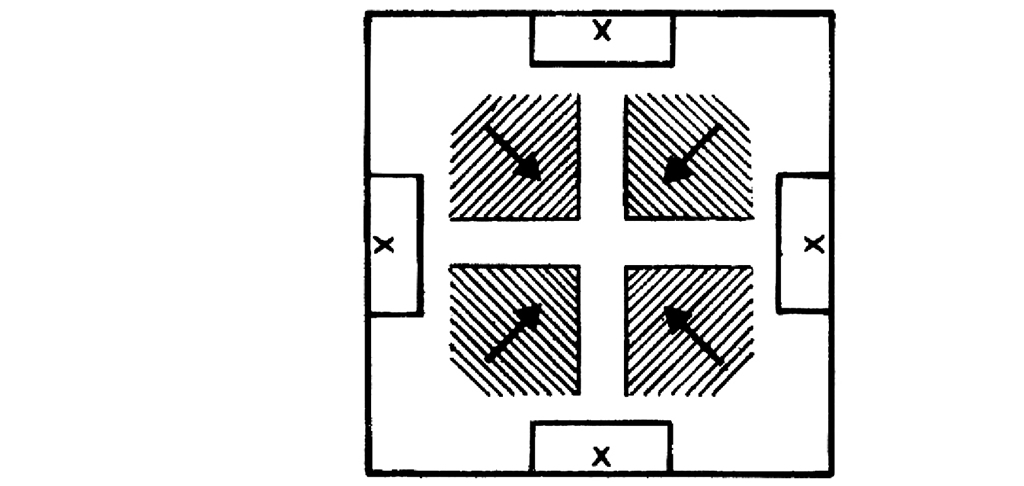
X conductors with backs to walls
Supplement (1986) to the preface of the 4 scores of CARRÉ
On September 1st 1986, CARRÉ was performed twice at the National Gallery in Berlin by the Radio Symphony Orchestra and RIAS Chamber Choir, conducted by Arturo Tamayo (I), Jacques Mercier (II), Lucas Vis (III) and Mark Foster (IV).
I had suggested the following programme:
CARRÉ
– intermission –
Explanations by me about the space composition
with 10 excerpts from the work –
second performance of CARRÉ.
Choice of the hall
One of the reasons the concert organiser selected the National Gallery was its dimensions (square): 24 m x 24 m. In the preface to the score of CARRÉ, it is stated that suitable dimensions for the hall are 25 m x 25 m. These dimensions corresponded to the size of Planten un Blomen (Hamburg) where the world première took place in 1960, and was meant to indicate how much space remained for the audience. This can be seen in the photographs which are reproduced in the 4 CARRÉ scores.
Although – at the National Gallery in Berlin – the proportions of the hall were favourable for hearing (it also had a very high ceiling), space remained for only 272 seats (even when the distance between chairs and podia was only 1.20 m, which is not sufficient). A series of circa 7 concerts with performances of CARRÉ should have been programmed.
The distance between the conductors was, therefore, 24 m.
In a hall measuring 30 x 30m – with circa 1.50 m between the orchestra
podia and the rows of seats and with a cross-shaped middle aisle 1 m in
width, a seating area of 16 m x 16 m for circa 420 chairs would remain.
In a hall measuring 35 m x 35 m, there would be room for circa 730 seats. The hall should not be larger, because otherwise the synchronisation of the conductors is endangered and listeners sitting close to one orchestra cannot properly hear the orchestra on the opposite side.
The hall of the National Gallery is encased in full-length glass windows and
marble, with stone floors and steel ceiling. It is so reverberant, that the first
tutti rehearsals were futile. Only after heavy black full-length theatre curtains
were hung behind the podia – one day before the performance – did
the acoustics improve.
During the rehearsals, traffic noise, flying airplanes, church bells, yelling
from outside, and telephones and public address systems in the neighbouring
rooms of the National Gallery could constantly be heard. Even during the
performances, every now and then street noise could be heard.
It is thus necessary for CARRÉ – especially because of the many general
pauses and soft passages – to choose a completely quiet, acoustically dry
hall with a high ceiling.
Podia
The podia should have been higher than 50 cm, for example 70 cm.
The audience should, by no means, be seated between the podia, as happened in Berlin – due to lack of space.
For the conductors, raised podia must be placed on the orchestra podia.
Lighting
At the National Gallery, a bar as long as a podium had been hung from the
ceiling above each orchestra. Fastened to each bar were three diffuse lamps
for the choir and orchestra and, in the middle, a spotlight which was aimed
at the conductor at an angle from the front.
This lighting was not ready for the first tutti rehearsal. The spotlights for
the conductors were missing, and thus the conductors could not see each
other properly, and several of the other lamps were defective. This greatly
hampered the rehearsals.
Thus, the lighting must, by all means, be completely installed and tested before
the tutti rehearsals begin.
Amplification of the cimbalom, harp and harpsichord
In the rehearsals for the performances in Berlin, these instruments were amplified
only in the third tutti rehearsal.
The pre-historic loudspeakers – and apparently the entire amplification
– hissed terribly. To reduce the danger of feedback, I installed the loudspeakers
beneath podiums III and IV, directly below the amplified instruments.
I placed the microphones (narrow-field) close above the strings of
the cimbalom, in front of the upper strings of the harp, and in the case of the
harpsichord beneath the low lid. In spite of this, the wood-winds and brass
leaked into the microphones. Acoustic walls could serve to laterally screen
the amplified instruments. Two microphones should be used for the harp:
one for the lower strings, and one for the upper ones.
The dynamic level of the two loudspeakers were adjusted only on the
loudspeakers themselves, which is complicated and completely inflexible. In
any case, a small mixer with 4 faders should be set up in the middle of the
hall, inconspicuously placed between the knees of the sound projectionist.
With this mixer he can individually control the dynamic level of the amplified
instruments. For the balance of piano, vibraphone (with hard mallets),
cimbalom, harp and harpsichord, it is best to have the musicians play in section
63x the chord-chains several times until they are balanced.
Sound projectionist
During the tutti rehearsals, definitely a sound projectionist (for instance an assistant conductor) should stand at the middle of the hall and make notes, as each section is rehearsed as to its dynamic level, synchronicity, the relation of the percussion instruments to the whole (effect of the beaters, especially in the cowbells), balance, visual impression, etc. He should then – section for section and with the conductors’ approval – suggest corrections.
The dynamic level should be corrected until each  can be heard even
from the most distant seat. It is therefore necessary, depending on the size of
the hall and its acoustics, to slightly raise the level of
can be heard even
from the most distant seat. It is therefore necessary, depending on the size of
the hall and its acoustics, to slightly raise the level of  compared to usual
performances.The dynamic levels
compared to usual
performances.The dynamic levels  and
and  are usually played too softly,
and between
are usually played too softly,
and between  and
and there is too much of a jump. This must be, by all
means, corrected by the sound projectionist.
there is too much of a jump. This must be, by all
means, corrected by the sound projectionist.
In Berlin, I made these corrections myself during three rehearsals and
would like, above all, to call attention to the fact that generally the percussion
instruments play and
and  loudly (tom-toms, snare drum roll, cowbells
with hard beaters,etc.). On the other hand, in section 93, I recommended
that the tam-tams be struck at full level.
loudly (tom-toms, snare drum roll, cowbells
with hard beaters,etc.). On the other hand, in section 93, I recommended
that the tam-tams be struck at full level.
The percussion instruments are always mixed with other instruments,
and these other instruments which are simultaneously played, must always
be audible.
During the rehearsals in Berlin, I constantly had to correct the winds and
strings because at the ends of notes they became softer, or they did not hold
out the notes for their full durations, or they slowed down the vibrati or tremoli.
Also the conductors made gestures at the ends of sections which suggested
a relaxation of the intensity and playing energy. I then made everyone
aware that: each note should be formed as something precious; each attack
should be consciously formed as an attack; each note should be sustained for
its full duration and never be allowed to fall; the energy of each note should
be held until its end and each decay should be articulated exactly as carefully
as its attack (therefore, rather a slight crescendo should be played at the end
of a held note, and the musical thought should extend beyond the rest which
follows). I said that the energy flow must remain intense until the last note
of the work, and that instead of repeatedly relaxing and falling, one should
constantly have the feeling of rising and holding; otherwise this music is
dead.
The sound projectionist must repeatedly measure each of the durations indicated in the score in seconds using a stop-watch, and inform the conductors of the differences. Usually, these durations are conducted too long. Although in the score it is said that they are only approximately binding, they should not be greatly exceeded.
For the duration of the fermatas I have suggested:
 circa 2",
circa 2",  circa 3",
circa 3",  circa 5",
circa 5",  circa 8".
circa 8".
The entire duration of CARRÉ should be circa 35 minutes, if no section is omitted.
Choir voicing
In the score, the voicing of the choir is indicated 8 - 8 - 8 - 8 or 12-12-12-
12. The world première in 1960 was sung with 12 - 12 - 12 - 12.
At the National Gallery in Berlin, 8 - 8 - 8 - 8 sung. Despite the small
hall, this voicing was too weak, especially the altos and basses. Per group, at
least 2-3-2-3 should sing (i.e. a total of 8-12-8-12), and when the hall
measures circa 35 m x 35 m, per choir 3-4-3-4 (i.e. a total of 12-16-12-
16).
The voicing 8 - 8 - 8 - 8 is possible if the individual groups in each
choir are amplified ( 4 x 4 microphones) and regulated by the sound projectionist
in the middle of the hall. Then, the loudspeakers must be situated behind
the choirs on high towers or – as in the case of the amplified
instruments – placed beneath the podia below where the singers are seated.
Percussion
The greatest errors take place during the selection
and hanging of the cowbells, in the choice of beaters
and in the manner of playing.
In the preface of the score there is a mistake:
the 12 cowbells do not all have the same pitches as
in my work GRUPPEN for 3 orchestras. In
GRUPPEN, namely, 13 cowbells are used, in
CARRÉ 12 are used, and 4 cowbells are different.
The manner of hanging the cowbells is the
same as in GRUPPEN. Thus, the lower edges of
the 3 cowbells of each orchestra must hang in a
horizontal line at eye-level of the standing player,
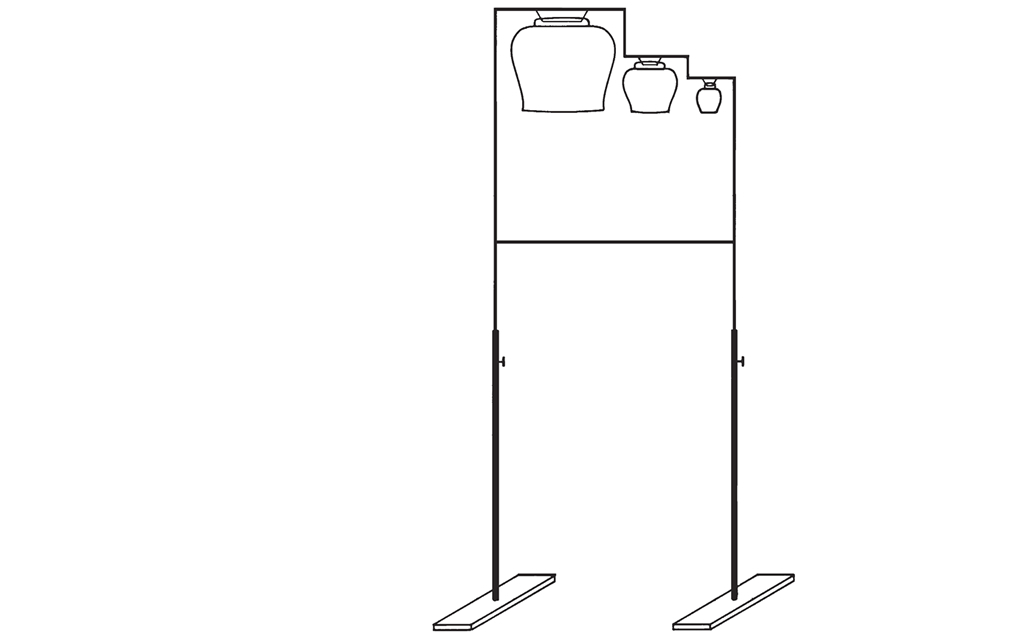
and the cowbells must be hit on their lower edges, diagonally from the front
or from the inside.
It is completely wrong to hit them in the middle or on the top, because
they simply sound bad when hit at those places.
When hit strongly, the small cowbells wriggle back and forth too much.
Therefore, either a nylon thread can be stretched at a slight distance behind
them so that they cannot swing too far, or a nylon thread can be attached to
the hook inside the cowbell where the clapper usually hangs and tied to the
stand below it.
For the Berlin performance, several cowbells were delivered which had
the wrong pitches (some of them 2 octaves displaced!), despite prior meetings
and demonstrations; all of the stands were wrong (much too low); the
beaters sounded – especially the "hard" ones – dreadful, for the most part.
Each of the cowbell players must occupy himself with the cowbells for a long time before rehearsals begin, study their characteristics, try them out and especially at "hard" imitate the sound which is produced by the iron clapper inside a freely swinging cowbell. Each conductor must first test all instruments and have 2 sectional rehearsals with the percussionists. Then, 1–2 tutti rehearsals with all percussionists should take place.
As gongs, Thai bossed (nipple) gongs should be used (and by no means
pseudo gongs such as those manufactured by Paiste, which are thin tamtams
with welded bosses).The 4 gongs may be pitched, for example, like the tom-toms:
As tam-tams, it is best to use Chinese Chau-Luo cast bronze tam-tams
having diameters of 70–90 cm.
The Indian bells should each be circa 1.7 cm in diameter. Each
bell has 4 slits and an iron ball inside. Circa 26 bells are strung
onto a circa 40 cm long closed wire loop, which should be stiff but slightly flexible.
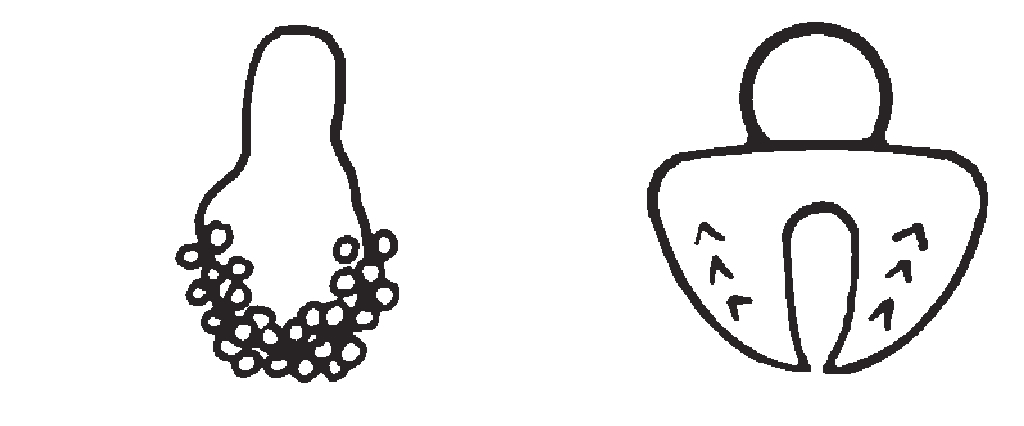
The wire loop is either hung and continuously shaken with the fingers from below for sustained rattling, and for accents hit with the same or with the other hand, or, the wire loop is held horizontally in the hand, and is tremulously shaken back and forth (gradually faster and more intensely at crescendo), and for accents the hand is quickly thrust back and forth, or the bundle is hit from below by the other hand (not on top of the bundle).
Usually, too many bells are strung onto the wire, with the result that the bells can no longer sound. Thus, they must be be strung quite loosely.
At some places, a continous rattling of the bells  , with drumstick
roll on the bundle of bells, is notated (for example orchestra I, sections 87,
89). At the Berlin interpretation I heard, however, the beating of the wooden
sticks on the bells disturbingly loud. Therefore it is, in fact, better to produce
continous rattling by shaking. But this requires a very special playing technique,
to avoid hearing a periodic rhythmical segmentation of the shaking
, with drumstick
roll on the bundle of bells, is notated (for example orchestra I, sections 87,
89). At the Berlin interpretation I heard, however, the beating of the wooden
sticks on the bells disturbingly loud. Therefore it is, in fact, better to produce
continous rattling by shaking. But this requires a very special playing technique,
to avoid hearing a periodic rhythmical segmentation of the shaking
Notation
Despite the instruction that an accidental applies to only one note, each
conductor must test all pitches played. Still in the next-to-last rehearsal I
discovered that a horn player had never understood this instruction and had
repeated each accidental to the end of a section.
Small notes should , as is said in the preface, be played clearly, and not
too fast. In CARRÉ their beams are explicitly not cancelled, but rather are
notated as eighth notes. Therefore, they should be played as eighth notes, but
more freely.
In section 58, for example, the percussionists played the cowbells extremely
fast and therefore completely unmusically (especially the beats with
the hard beaters). Several repetitions were necessary before I could comprehend
the notated groups etc.
etc.
as speech-like articulations, and the individual groups were separated by
pauses.
Phonetics
When rehearsing with the choir, the choir director must be thoroughly familiar
with the phonetic alphabet and its pronunciation. During the tutti rehearsals
for the Berlin performances I still heard gross pronunciation mistakes
and could not correct them all in the short time remaining. Many times,
voiceless consonants were called or sung voiced, graphically notated durations
for syllables shortened, passages with falsetto sung loudly, where  is
prescribed
is
prescribed
It was not clear to the singers that vowels standing next to each other should
not to be spoken as an umlaut but rather that each was to be spoken separately;
for example in choir II, section 18, at  the two vowels are called
one after the other, the
the two vowels are called
one after the other, the  therefore with accent, and not slurred as
therefore with accent, and not slurred as  or
as umlaut
or
as umlaut  .
.
All statistical tongue-clicks and finger-clicks were made much too fast and densely, so that only a mess of impulses was heard. The synchronous handclapping was almost always uncoordinated, because before the clapping began, the distance between the hands was completely different, so that at each entry a series of claps was heard.
Rehearsals
The rehearsal plan for the world première in 1960 is printed in the score. The
rehearsals at that time were very limited (the orchestra was simply not made
available for a longer period of time, and the hall was allegedly not free for
more tutti rehearsals).
At several moments during the preparations for the 1986 Berlin performance
I noticed the attitude "that nowadays the musicians learn such a
work much faster."
This attitude is false. It will always be necessary forever to have at least
as many rehearsals as those for the world première. At that time, we did not
know anything about the performance practice of the work, and the rehearsals
had to be set far in advance.
Therefore in Berlin, fewer rehearsals for the choir and orchestra were
planned, and the result was accordingly approximate (there are, as proof, recordings
of both performances!). In order to reach a truly adequate performance
quality, more sectional rehearsals must be planned than are prescribed
in the score and, to be sure, an entire additional day for tutti rehearsals.
I have already mentioned sectional rehearsals for the percussionists of
each group and for all percussionists together. There should also be one
rehearsal in the concert hall for each of the following: choir alone; piano -
vibraphone - cimbalom - harp - harpsichord alone; brass alone (several
times during the tutti rehearsals and even during the performances individual
brass mutes fell loudly onto the floor because no proper stands had been
foreseen for the mutes...)
When will the time finally come, when it will be possible to perform CARRÉ carefully, with enough rehearsal time for working on details, for making acoustical experiments, as well as for arriving at a perfect balance?
CARRÉ – Please fight for this amplification
Dear David Robertson,
today I saw in a program that you are going to conduct CARRÉ.
During the various performances I have learned that the choir must be
amplified. Originally 4 x 16 (in each group
4 x S
4 x A
4 x T
4 x B),
later performances had 4 x 3 singers. This lead to a completely unbalanced
sound: sopranos and tenors too loud, basses and also altos too soft.
Therefore it is necessary to balance with
4 x 3 sopranos = 12
4 x 4 altos = 16
4 x 3 tenors = 12
4 x 4 or 5 basses ! = 16 or 20
But the BBC-choir certainly does not have 20 good bass singers; and the
BBC bass-singers are rather thin.
Please look for a good sound projectionist in the middle of the hall with the
mixing console (32 inputs, 8 outputs) and 4 x 8 microphones:

and 8 big loudspeakers on 8 towers, each 4 m high:
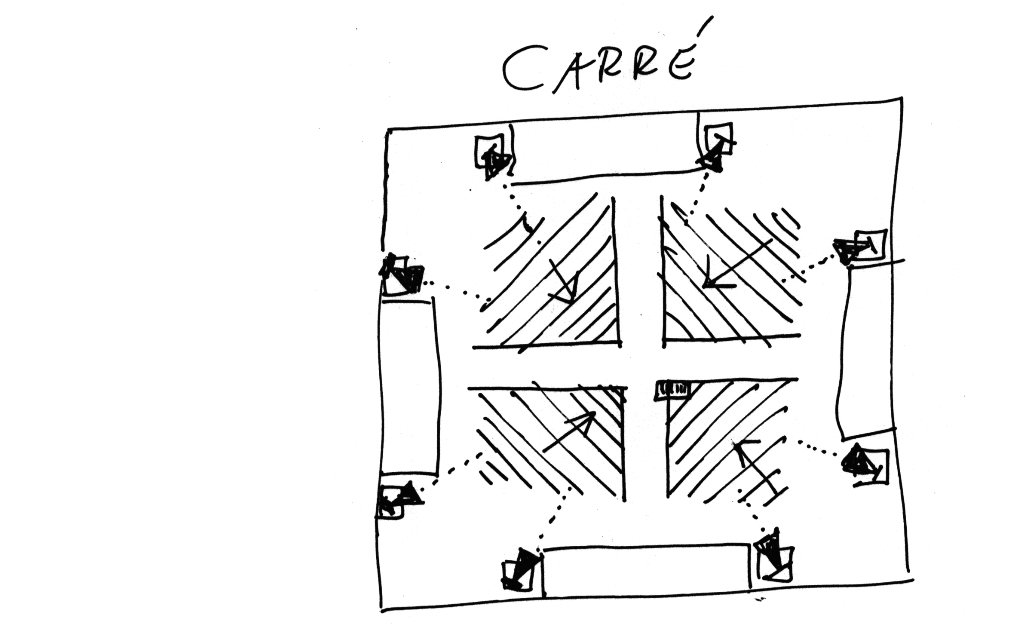
In the beginning all the bass singers should sing louder ( instead of
instead of  ):
):
the low  is written for real low basses ("Don-Kosaken").
is written for real low basses ("Don-Kosaken").
Please fight for this amplification: it will be hard ("money"...), but the music is the most important!
Sincerely yours
Stockhausen
P.S. The sound projectionist should help the four conductors during the rehearsals by telling them (writing always the details) everything about the balance ("cow bells too loud...").